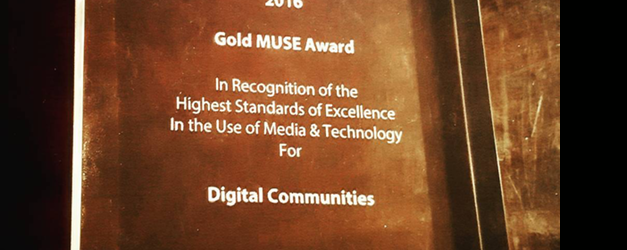Tag: Transcription Center
All that Glitters is GLAM: Gold MUSE Awards

The Smithsonian Transcription Center won a Gold MUSE Award for Digital Communities from the Alliance of Media & Technology in May at the Alliance of American Museum conference in Washington, D.C. I’m delighted that the efforts of our team of volunteers, staff members who share so much time and knowledge, and the Office of the Chief Information Officer were acknowledged formally by this award. We do it together and we continue to grow.
Here is what the juries had to say about the Transcription Center:
“The Smithsonian Institution Transcription Center is a volunteer-supported transcription website at a large scale. The website is smooth and easy to use, participation is rewarding, and the whole experience reflects well on the Smithsonian brand. The jury especially appreciates the way volunteers are made to feel special.” (via Dacia Macengill’s post for the Center for the Future of Museums)
As annual awards from The international Alliance Media & Technology Professional Network, The MUSE Awards “are presented to institutions or independent producers who use digital media to enhance the GLAM experience and engage audiences. The MUSE awards celebrate scholarship, community, innovation, creativity, education and inclusiveness.”
Learn more about the 2016 winners: fabulous, well-designed, and inspiring projects from peer organizations across the museum and cultural heritage sector. Watch for more details of the Transcription Center’s appraisal in the December issue of Museum.
Historically Speaking: Transcription, Collaboration, & Crowdsourcing
Last week, Forbes’ contributor Nathan Raab wrote about transcription, collaboration, and crowdsourcing for his Historically Speaking blog. I’m quoted in the piece that focuses on the ways institutions like the Smithsonian and the National Archives are “using technology to engage the public in the discovery and preservation of its own history.”
Nathan interviewed me about my role in the development of narrative strategies and understanding engagement with the Smithsonian Digital Volunteers Transcription Center. In our discussion, I highlighted
- the potential for collaboration between institutions serving as stewards for history and culture,
- the ways in which we are actively making knowledge more easily accessible and available for (re)use, and
- the fantastic stories emerging around the collections, as well as the motivations transcription participants are sharing with us
Here’s my part of the discussion from the blog post:
“Technology is opening doors for people to learn and explore and create an understanding of the world around them.” said Dr. Meghan Ferriter, who consulted on the project at the Smithsonian. “There are a lot of people doing related and overlapping projects, but nobody’s connected all of the pieces yet.”
You can already see the ball rolling. Ferriter notes that many organizations have to start work from scratch, but the Smithsonian is working on changing that. She tells me, “In my role as Research Associate, I am in essence creating a series of recommendations that can be used here at the Smithsonian and elsewhere. This is… something of a strategic plan. We are aiming to share best practices around the world.”
Click through to the full article to learn more about the landscape of crowdsourced participation in transcription – that is, “Americans taking part in the discovery and preservation of American history.”
From SIA: Can You Relate? Themes and the Transcription Center
Read about the ways that organizing collections through themes can uncover relationships between materials in the Transcription Center at this post I wrote for SIA Bigger Picture Blog.
Great news! The Smithsonian Digital Volunteers Transcription Center is back up and live!! As you check out the improved features and try your hand at transcription (and reviewing!), consider the ways we may be able to organize existing and future collections. This post I wrote for the Smithsonian Institution Archives Bigger Picture Blog last week suggests several themes. Do you have any other suggestions?
Finally, reorganizing and finding new relationships between materials may also allow us to ask new questions – using the data from the transcribed pages to answer lingering questions and round out new stories. We can also learn more about and provide context for the successes and challenges the scientists, artists, and authors faced; and how these experiences relate to our lives today.
Smithsonian Institution Transcription Center in Beta
We launched the Smithsonian Digital Volunteers Transcription Center Friday 21 June as a collaborative, crowdsourced process that aims to bring digitized collections out from archives and museums. We are inviting our SERIOUSLY AMAZING audiences to help us unlock their stories by transcribing and reviewing their contents – to make them more accessible, searchable, and open.
This is another outstanding opportunity to make webs of knowledge and learn about the connections between collections. Please jump in and help where you can!
**UPDATE** (14 October): The Transcription Center is fully back in business with new features to launch shortly – while many projects have been moved to completion, there are still plenty of pages to transcribe and review. Join the community of digital volunteers!
My role has involved advising on use for communities of practice, understanding crowdsourcing capabilities, and developing coherent narratives for the pieces – rather than technical development – but I welcome feedback on usability, design, and any other “would be nice.”
Feel free to transcribe and offer feedback if you have thoughts to share! The service is still in beta and we are constantly integrating what we learn from users. Thanks for allowing me to share this successful first step in our transcription process – more to follow…
